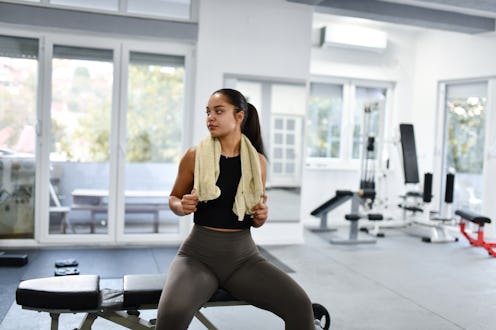Fitness
How Long Should A HIIT Workout Be? Here's The Deal
It’s short but not that short.

HIIT workouts are meant to be fast and furious. They rely on explosive exercises like burpees, high knees, kettlebell swings, sprints, and other moves that spike your heart rate and make you sweat — quickly. This fitness modality style gives you a lot of bang for your buck, so how long does a HIIT workout actually need to be?
HIIT, or high-intensity interval training, is an exercise format that alternates short bursts of cardio activity with periods of rest or light exercise like walking in place, says Ronny Garcia, a certified personal trainer for Blink Fitness. “A HIIT circuit can include running, cycling, and bodyweight exercises,” he tells Bustle. “Basically, HIIT serves as a framework and then you can modify and personalize it based on your fitness level, equipment available, and the amount of time you have.”
According to Michael Hamlin, NSCA, CSCS, a personal trainer and founder of Everflex Fitness, a typical HIIT workout looks like this: You’ll choose a couple of fast-paced exercises (like mountain climbers, sprints, or jump squats) and do each as hard as you can for 20 to 60 seconds. Rest between each exercise for 10 to 20 seconds, and then repeat the circuit three to five times. Add in a warm-up and a cooldown, and you’ll be good to go.
These workouts are the perfect format when you want to break a sweat without spending an hour at the gym, but Garcia notes there’s often confusion around how long a HIIT routine should be. Keep reading for the breakdown, straight from fitness experts.
How Long Should A HIIT Workout Be?
The ideal length of a HIIT workout depends on your fitness and energy level, goals, and time constraints. Technically, it doesn’t really matter if you want to work out for 10, 15, or 30 minutes — with HIIT, you’re still going to reap the benefits.
“A 10 to 30-minute HIIT workout can provide significant benefits without being too exhausting or time-consuming,” Hamlin says. In this amount of time, you can move through several circuits, do multiple exercises that work different muscle groups, and give your heart a good workout.
If you’re in a rush and want a quick exercise break, you can even get away with five minutes of HIIT. Choose an intense exercise, like burpees, and it’ll be enough to elevate your heart rate for a great mini workout, Hamlin says. Five minutes of HIIT is an approachable entry point for beginners, too, so don’t be afraid to keep your workout short and sweet.
When you aren’t sure which length to go with, Garcia says 20 minutes of HIIT is a good sweet spot. “This is because HIIT is a high-intensity workout that can be harder on the body,” he explains. You’ll definitely be tired after 20 minutes, but you won’t be completely wiped out. And that’s a good thing.
What Happens If You Do Too Much HIIT?
While 45 and 50-minute HIIT classes do exist, you have to be a little more careful when exercising at high intensities for longer periods of time. “Doing a 45-minute HIIT workout can be beneficial, but it may also increase your risk of injury or burnout, [especially] if you don't allow your body enough time to recover between workouts,” Hamlin says.
You’ll know your HIIT workouts are too long or that you aren’t properly recovered if you feel general fatigue, you can’t sleep, you keep getting injured, you lose motivation, or you struggle to use good form during your exercises, Hamlin says. These are all signs your body and mind are tired and you should cut back, decrease the length of your HIIT routine, and add more stretches, active rest workouts, and days off.
As Hamlin says, “It's crucial to balance your HIIT workouts with other types of exercise and allow enough time for rest and recovery.” Those are just as important for your fitness routine, after all.
Studies referenced:
Ito, S. (2019). High-intensity interval training for health benefits and care of cardiac diseases - The key to an efficient exercise protocol. World J Cardiol. doi: 10.4330/wjc.v11.i7.171.
Sources:
Ronny Garcia, certified personal trainer for Blink Fitness
Michael Hamlin, NSCA, CSCS, personal trainer, founder of Everflex Fitness
This article was originally published on